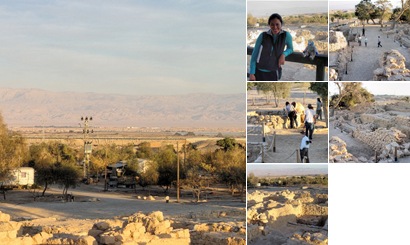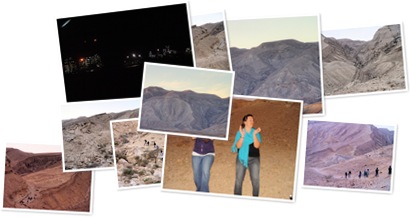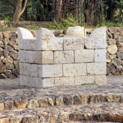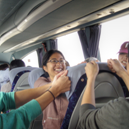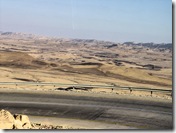JERUSALEM JOURNAL: DAY 12– THURSDAY, JANUARY 7, 2010
Tonight we are at the Masada Guest House, and tomorrow we will be going to the top of Masada. Todd appears to be softening a little, because he is going to buy tickets on the tram for all those who don’t want to hike to the top (about a 45 minute steep climb). I have a feeling that the Rigsbys spoke with him about being a little more compassionate toward some of the “students,” especially us older ones. The hotel is really a hostel, but the rooms are sizeable and clean. At the same time, however, I have come to hate twin beds.
Our first visit was paid to the Coral Beach Nature Reserve, at Eilat, where we were invited to snorkel and view the coral reefs. The wind was blowing, however, and the water was cold, so I passed on the activity because I appear to be coming down with a sore throat and a cold. As we looked across the mountains toward Jordan, we were reminded that Jordan used to be Edom. The capital of Jordan is Amman, and the temperature there can get to be 110°F in the summer.
Next we visited Timna, the site of a full sized replica of the Tabernacle and the Ark of the Covenant. The site is run by Messianic Jews. The valley in which it is located is a copper mining area. Copper is and was important, because it is used in making bronze. One of the features of the valley was Solomon’s Pillars, formed by erosion and, of course, having nothing to do with King Solomon.
Exodus, Chapter 35 instructs the Israelites to build a sanctuary so that “I may dwell in you.” The way to God, at that time, was through blood sacrifice, and, as the woman explained, today, there is only one way to the Tabernacle, and that is through Jesus Christ.
The sacrificial altar was made of Acacia wood, covered with copper and had four horns. A copper lavabo was used for washing hands and feet to insure purity. To construct the bowl, the women of the Exodus gave their mirrors, which were made of copper. All of the Tabernacle and the Ark of the Covenant moved with the Israelites as they traveled.
Only the priest could go into the Holy of Holies. And that was on the Feast of Yom Kippur. Inside the Holy of Holies, there were twelve loaves of bread, one for each tribe in Israel. Only the priests were allowed to eat the bread. The Lord allowed David to do so, and he was not punished, because he was hungry and in need of food. Jesus refers to this when he says that man was made for the Sabbath; the Sabbath was not made for man. The menorah is the only light in the Tabernacle. Also in the Holy of Holy’s is the altar of incense, and the High Priest wears pomegranates and bells hanging on his robe and an ephod (or breastplate) containing twelve precious stones, one for each tribe of Israel. For those who suggest that there is nothing biblical that suggests vestments, I would point out that the Old Testament suggests otherwise.
When Jesus died, the veil of the temple, where the Ark of the Covenant was kept, was rent in two, from top to bottom. In Israel, when somebody died, those who mourned tore their clothes. In the case of the crucifixion, God was mourning the death of His only beloved Son.
During biblical times, the Nabateans was the only group that was able to survive in the heat and the two to four inches per year rainfall in the desert. They were able to do so because they developed a technology for conserving water that we are still trying to understand. This is also the area in which Hadad, the Edomite, rebelled against Solomon and refused to pay tribute to him.
Tamar is a fortress which guarded the route across the desert. It dates from 1000 to 600 BC. We know that Moses passed this way, and he asked the Edomites and the Moabites permission to pass over their land. They refused, and because they were related, Moses made a detour to the Way of the Wilderness. The Amorites, however, were not related to the Israelites, but were one of the groups that occupied Canaan. When they refused passage rights to Moses, Moses wiped them out (See Numbers 21). This was also the area (at Punion) where the new generation of Israelites complained that there was no decent food, and God sent snakes to bite and kill them. When they repented, however, God had Moses create a Bronze snake which, when they were bit, the Israelites could look at, and they were cured. John 3:14-15 compares the raising of that staff to the raising up of Jesus so that we might be saved. Hezekiah, in fact, destroyed that snake, because it was being used as an object of veneration, and like the Gospels suggest, if something offends you or your brother, you pluck it out.
At the site, they also found an Edomite shrine. Moab is located between the Amon and Zared Valleys. Edom is south of the Zered, and it is quite possible raiders came across the desert and used this site. David, who sacrificed Uriah the Hittite in battle, conquered the Amonites.
ASCENT OF AKRABBIM (WAY OF THE SCORPIONS):
Boundary allotments in both Numbers 34 and Joshua 15 mention the Ascent of Akrabbim. Some of our braver students worked their way up the mountain while the rest of us stayed back and took pictures of them. From there we proceeded to Masada in almost total darkness except for sporadic oil or gas fields.


















